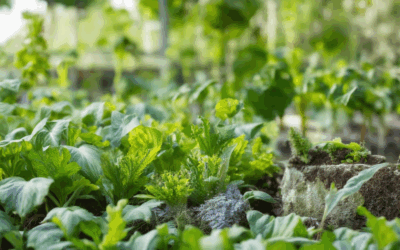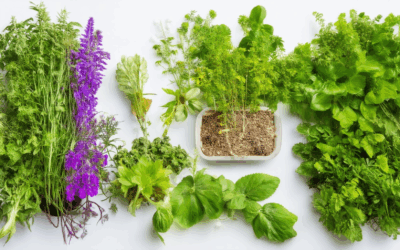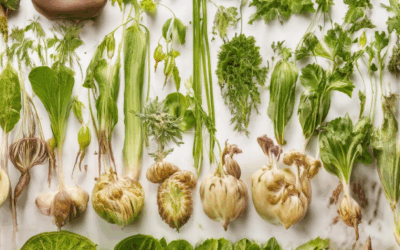Organizing a seed bank can seem daunting, but with the right strategies, it becomes a breeze. Whether you’re preserving garden varieties, heirloom seeds, or building a collection for future gardening projects, effective organization is key to maintaining seed viability and ensuring successful growth. In this comprehensive guide, we’ll walk you through essential seed bank organization tips, providing practical advice for keeping your seeds safe, accessible, and ready for planting. From selecting the perfect containers to exploring organizational methods that maximize space and minimize clutter, this article offers actionable insights for anyone looking to master the art of seed preservation. By following these expert tips, you’ll not only enhance your seed-saving efforts but also gain peace of mind knowing your treasures are well-preserved for years to come.
Key Takeaways
– Plan Thoroughly: Define your seed bank’s purpose, select high-quality seeds, and invest in appropriate storage solutions.
– Categorize Seeds: Organize seeds by type, species, and usage for easy access and management.
– Proper Storage: Use labeled containers, maintain a cool, dark, and dry environment, and employ silica packets to prevent moisture buildup.
– Implement Seed Rotation: Regularly use older seeds to maintain freshness and genetic diversity, supported by detailed inventory tracking.
– Monitor Conditions: Continuously check for pests, adjust storage settings, and keep thorough documentation of your seed collection.
– Collaborate and Stay Informed: Engage with expert networks, participate in seed swaps, and stay updated on the latest advancements in seed banking technology.
– Consider Environmental Factors: Protect your seed storage area and prepare for emergencies with a secure backup cache.
– Review and Update Regularly: Periodically audit your collection, discard expired seeds, and refine your practices to ensure long-term viability and sustainability.
These takeaways encapsulate the essential steps for effectively organizing a seed bank, balancing practicality with SEO-friendly keywords to provide actionable insights for readers.
How to Organize a Seed Bank
To effectively organize a seed bank, follow these steps to ensure your seeds remain viable and accessible for future use.
1. Choose the Right Location
- Select a cool, dark, and dry place to store your seeds. Ideal temperatures range between 35°F to 50°F (2°C to 10°C).
- Basements, pantries, or root cellars are excellent options due to their stable temperatures and low humidity.
- Avoid areas with high humidity or temperature fluctuations, as this can cause seeds to degrade prematurely.
2. Proper Labeling
- Label each container with the name of the plant, the specific variety, and the date of harvest. This ensures easy identification and rotation of seeds over time.
- Use clear and durable labels that can withstand changes in temperature and humidity.
- Consider grouping seeds by season or usage frequency to streamline access during planting time.
3. Storage Methods
- Store seeds in airtight containers such as glass jars, plastic containers with lids, or vacuum-sealed bags.
- For long-term storage, consider using silica gel packets to absorb moisture and keep seeds dry.
- Seeds can be stored in small envelopes or labels for easy sorting and retrieval.
4. Seed Rotation and Reharvesting
- Plan to rotate seeds every 2-3 years to ensure fresh stock is available for planting and to prevent old seeds from being used.
- Mark seeds as expired after several years to avoid accidentally sowing outdated varieties.
- Test seed viability annually by attempting germination rates to confirm their effectiveness.
5. Best Practices for Seed Storage
- Keep the storage area free from pests, as insects can damage seeds and reduce their viability.
- Avoid exposing seeds to direct sunlight, as UV rays can weaken their genetic integrity over time.
- Do not store seeds in areas with high humidity, as mold and mildew growth can contaminate them.
Common Mistakes to Avoid
- Never leave seeds in warm or humid environments, as this accelerates spoilage and reduces germination rates.
- Do not store seeds in paper bags or cardboard boxes, as they are prone to absorbing moisture and cracking.
- Avoid using plastic wrap or foil, as these materials trap moisture and can lead to mold growth.
By following these guidelines, you can establish a successful seed bank that ensures the preservation and availability of your favorite plant varieties for years to come.
For more tips on seed preservation and organizing your seed collection, visit our comprehensive guide and explore our in-depth resources .
Best Way to Organize Seeds
Organizing seeds efficiently is crucial for maintaining a thriving garden or farm. Here’s a step-by-step guide to help you get started:
- Categorize Your Seeds
- Vegetable seeds
- Flower seeds
- Herb seeds
- Fruit trees and bush seeds
- Grass and lawn seeds
- Use a Seed Organizer Tool
- Seed Boxes : These are designed to store seeds neatly and protect them from pests.
- Diy organizers made from recycled materials like egg cartons or old shoeboxes with holes punched for air circulation.
- Store Seeds Properly
- Label all containers with the seed name, variety, and date stored.
- Keep seeds in a cool, dark, and dry place to prevent germination and mold growth.
- Consider using refrigeration for long-term storage of certain seeds.
- Organize by Usage Season
- Separate seeds based on the time of year they are typically sown.
- Spring and summer planting seeds in one container, fall and winter in another.
- Maintain and Rotate Stocks
- Use older seeds first to avoid waste.
- Replenish stocks regularly to ensure variety and freshness.
- Pest Control Measures
- Store seeds in containers with tight-fitting lids or in glass jars.
- Keep storage areas free from rodents and insects by using natural deterrents .
By following these tips, you can keep your seeds organized, protected, and ready for use whenever you need them.
How to Prepare a Seed Bank
To establish a successful seed bank, follow these organized steps:
1. Selecting the Right Seeds
- Select seeds based on their viability, adaptability to local conditions, and genetic diversity.
- Consider heirloom varieties, open-pollinated crops, and native species for resilience.
- Choose seeds that are free from pests, diseases, and contaminants.
2. Storing Properly
- Store seeds in a cool, dry, and dark environment to prevent germination inhibitors.
- Maintain a consistent temperature between 32-41°F (0-5°C) for optimal seed viability.
- Use airtight containers, preferably made of glass or metal, to protect against moisture and pests.
- Label each container with the seed variety, source, and date stored.
3. Germination Testing
- Test seeds periodically to ensure germination rates remain high.
- Place seeds on damp paper towels in a container and check for sprouting within 7-14 days.
- If germination fails, discard the batch and replace with fresh seeds.
4. Long-Term Storage
- Transfer seeds to a climate-controlled vault for extended storage if possible.
- Monitor for signs of mold, rot, or insect infestation and address issues promptly.
- Rotate stock annually to maintain genetic diversity and health.
By following these steps, you can establish a robust seed bank that ensures the preservation of valuable plant genetics for future generations. For more detailed guides and resources, visit OldSeed.org .
Disadvantages of Seed Banks
- Limited Plant Compatibility: Not all plant species can be stored in seed banks due to specific environmental requirements. This may result in the loss of genetic diversity for certain plants.
- Challenges in Managing Conditions: Seed banks require controlled environments, and failures in these systems can lead to significant seed loss, affecting conservation efforts.
- Not All Plants Can Be Stored as Seeds: Some plants lack viable seeds or seeds that do not store well, necessitating alternative methods like tissue culture or cryopreservation, which can be costly and complex.
- Geographic and Species Bias: Seed banks often focus on specific regions or plant types, potentially neglecting others, thereby limiting genetic diversity available for restoration.
- Risk of Contamination: Seeds may become contaminated with weeds or other unwanted plants, reducing their effectiveness for future use.
- High Resource Demands: Maintaining seed banks requires significant resources, which may not be accessible to all regions or organizations, limiting their utility.
- Reduced Viability Over Time: Seeds can lose their germination capacity over years, diminishing the effectiveness of seed banks as long-term conservation tools.
What Are the Key Steps to Effectively Organize a Seed Bank?
Organizing a seed bank requires careful planning and attention to detail to ensure long-term viability and accessibility. Below are the essential steps to establish and manage an effective seed bank:
- Plan and Prepare
- Define the purpose of your seed bank, whether for personal use, conservation, or commercial purposes.
- Research and select high-quality seeds that meet your goals, such as heirloom, open-pollinated, or organic varieties.
- Invest in proper storage solutions, such as airtight containers, and consider using silica packets to regulate moisture levels.
- Categorize Your Seeds
- Organize seeds by type, such as vegetables, flowers, herbs, and heirlooms.
- Further categorize by species, strain, or variety within each type for easier access.
- Consider grouping seeds by their growing season or usage, such as spring planting or culinary uses.
- Store Seeds Properly
- Use labeled jars or containers to keep track of each seed type and its source.
- Store seeds in a cool, dark, and dry location, ideally between 32°F and 50°F (0°C to 10°C).
- Place silica packets or desiccant bags inside containers to absorb excess moisture and prevent mold growth.
- Label all containers with the seed name, date of purchase, and expected germination date.
- Implement a Seed Rotation System
- Rotate seeds regularly to maintain freshness and genetic diversity in your collection.
- Use older seeds first to make room for newer varieties and ensure timely planting.
- Keep a record of your seed inventory to track aging seeds and plan future purchases accordingly.
- Maintain and Monitor
- Periodically check containers for signs of pests, such as beetles or weevils, and treat infestations promptly.
- Monitor seed expiration dates and discard seeds that no longer meet germination standards.
- Update your seed bank collection annually to reflect changes in availability and demand.
- Consider Environmental Factors
- Ensure your seed storage area is protected from temperature fluctuations and humidity changes.
- Prepare for emergencies by creating a backup seed cache stored in a secure location.
- Stay Informed and Network
- Join online communities or local gardening groups to share knowledge and learn from experienced seed collectors.
- Follow reputable sources like Seed Savers for tips and resources.
- Participate in seed swaps or exchanges to expand your collection and gain diverse seed options.
By following these steps, you can create a well-organized and sustainable seed bank that meets your needs while contributing to biodiversity and food security. Remember to always source seeds from trusted suppliers, such as Johnny’s Selected Seeds , to ensure quality and genetic integrity.
Key Steps to Effectively Organize a Seed Bank
Organizing a seed bank requires careful planning and attention to detail to ensure the long-term viability and accessibility of your seeds. Below are the essential steps to effectively manage your seed collection:
1. Categorize Your Seeds
Categorize your seeds into distinct groups based on their type, purpose, and origin. Common categories include:
- Vegetable seeds
- Flower seeds
- Heirloom or rare seeds
- Specialty crops
2. Implement Proper Storage Solutions
Store seeds in a controlled environment with stable temperature and humidity levels. Use:
- Labeled glass jars or airtight containers
- Silica packets to absorb moisture
- A cool, dark, and dry location (ideally between 32-41°F)
3. Practice Seed Rotation
Regularly rotate your seeds to use older stocks first, preventing spoilage and ensuring fresh seeds are available for planting.
4. Maintain an Inventory System
Keep detailed records of your seed inventory using spreadsheets or databases. Track:
- Seed name and variety
- Source and date of acquisition
- Quantity and storage duration
- Germination rates
5. Monitor Storage Conditions
Regularly check and adjust the storage environment to maintain optimal conditions. Monitor:
- Temperature fluctuations
- Humidity levels
- Pest activity
6. Utilize Preservation Methods
Consider advanced preservation techniques such as:
- Vacuum sealing
- Low oxygen environments
- Temperature-controlled storage for sensitive seeds
7. Document Everything
Maintain thorough documentation for each seed lot, including:
- Seed description
- Storage history
- Expiry dates
- Usage logs
8. Conduct Regular Audits
Periodically review your seed collection to identify expired or damaged seeds and address any issues promptly.
9. Collaborate with Experts
Seek advice from agricultural professionals, botanists, or geneticists to enhance your seed banking practices and gain access to valuable resources and networks.
10. Review and Update Regularly
Stay informed about the latest advancements in seed banking technology and update your practices accordingly to maintain the health and diversity of your collection.
By following these steps, you can establish a well-organized and sustainable seed bank that meets your current and future needs. For further insights and resources, explore our guide on heirloom gardening and sustainable agriculture at Old Seed .








0 Comments